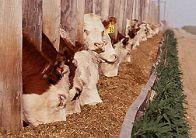Forage-Livestock Systems
 Forage-Livestock Systems focus on interdisciplinary basic and applied research on forages and the animals that consume them. Southwest Kansas livestock producers must be able to manage a profitable business that is also sustainable in terms of environmental stewardship. Forage-Livestock Systems utilizing both grasses and legumes for stored feed, as well as for grazing can have a positive impact on sustainable agriculture in Kansas. Forage crops are one of the few resources that can be converted to food while sustaining and restoring our soil, water and atmosphere.
Forage-Livestock Systems focus on interdisciplinary basic and applied research on forages and the animals that consume them. Southwest Kansas livestock producers must be able to manage a profitable business that is also sustainable in terms of environmental stewardship. Forage-Livestock Systems utilizing both grasses and legumes for stored feed, as well as for grazing can have a positive impact on sustainable agriculture in Kansas. Forage crops are one of the few resources that can be converted to food while sustaining and restoring our soil, water and atmosphere.
Within a particular county, or even community, the basic forage resource may be quite different. Soil, kind of grass, dryland or irrigated forages, cool-season or warm-season and even annual or perennial plants make up part of that diversity. There is not one plan or program that fits all. Consequently, there is no "right or wrong" forage program. Each producer must make careful selections. Any forage program must result in the most economical method that results in good livestock performance and is environmentally sound.
Each producer should match the forage program to the cattle needs or base the cattle to the forages that are available. A producer's overall forage production philosophy has an important influence on the type of forage program developed.
Assemble the System
Producers should start with the inventory of the forages that they already have and develop the livestock program around the resource. Generally, the animal portion is either already on hand or we want to have a particular animal program, and then try to make an existing forage situation fit the needs of the livestock.
While inventorying their forage source, producers should write down acreage and kind of forage. Not when it is high quality and when quality is low. Make an estimate of yields. Work on averages. It is better to have more forage than expected instead of the reverse.
Next, inventory your animal requirements - cow/calf or yearlings, fall-calving or spring-calving. Does the forage that you currently have "line up" with the high nutrient requirements of the yearlings or cows during the first three months after calving? Grass farmers will establish forages as needed to fit the animals' nutritional needs.
Evaluation
One would like to say if you made money, you must have a good program. But with depressed cattle prices, the one that loses the least may be a better evaluation tool.
In reality, forage programs must be evaluated on such things as:
- Weaning weight and cow conception rates;
- Stocker grains: spring, summer, fall and winter;
- Condition of perennial forage pastures;
- Amount of hay purchased;
- Animal health problems;
- Was the producer happy with the results?
